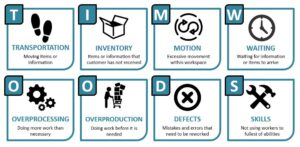Exposing Waste in the Value Stream
Introduction
In the last episode, we presented the required tools for constructing a Lean organisation. It is essential to highlight, however, that for a Lean organisation to operate properly, its value stream and non-value contributing activities(wastes) must be eliminated This article examines the various types of waste and practical ways in which they appear in various industries. The term “waste” in Lean manufacturing refers to any action that does not add value for the client. Waste is essentially any extraneous step in the production process that does not benefit the client and that they do not want to pay for. Eliminating waste from a production process is at the heart of Lean manufacturing. Wastes are eliminated, leaving only the actions necessary to deliver a satisfying, now highly valued product to the customer.
Mr. TIMWOODS is a Bad Man!!!

Historically, Taiichi Ohno, the Chief Engineer at Toyota, devised the first seven wastes (Muda) as part of the Toyota Production System (TPS). Transportation, Inventory, Motion, Waiting, Overproduction, over processing, and Defects are the seven wastes. They are frequently designated by the abbreviation ‘TIMWOOD’. In the 1990s, when the Toyota Production System was applied in the western hemisphere, the eighth waste of underutilized talent or ‘Skills’ of workers was introduced. Consequently, the eight wastes are generally known as “TIMWOODS.” In the section that follows, we will analyze each of these wastes in depth.
Let Us Learn More About These Wastes…
Transportation. The term “transportation waste” refers to the unnecessary movement of people, tools, inventory, or products. Excessive material movement might result in product damage and faults. In addition, excessive mobility of personnel and equipment can result in extra effort, increased wear and tear, and fatigue. The most typical sources of transportation waste are poor warehouse design, double handling, etc.
Example: Warehouses increase transportation waste when they move products unnecessarily. Transport waste results in the rental or acquisition of surplus warehouse space and surplus merchandise. In addition, you may face increased energy expenditures and forklift operations, among other issues.
Inventory. It is often difficult to consider surplus inventory as waste. In accounting, inventory is considered an asset, and suppliers frequently offer discounts for bulk orders. Having more inventory than is required to maintain a steady flow of work, however, can result in issues such as product flaws or damaged materials, longer lead times in the production process, inefficient capital allocation, and difficulties that are buried in the inventory.
Example: Many manufacturing companies generate this form of inventory waste by maintaining excessive volumes of completed goods inventory. When excess completed goods inventory moves slowly or becomes obsolete, it is very costly. Not only does this tie up valuable cash flow and resources, but it also produces opportunity costs.
Motion. Any needless movement of people, equipment, or machinery is motion waste. This includes moving, walking, lifting, reaching, bending, and stretching. Tasks requiring excessive movement should be adjusted to improve the work of workers and raise health and safety standards.
Example: In the banking space, in contrast to “transportation,” “motion” refers to the movement of workers. Both are far more difficult to see in service environments compared to production environments. Motion may manifest as persons frequently jumping between multiple computer domains or drives, or simply needing to press too many keys to complete a computer activity. Wasted motion can involve walking, reaching for items, searching for files and inventories to discover what is needed, excessive mouse clicks, and double data entering.
Waiting: Waiting as a waste includes activities such as inactivity and lines. The nonproductive use of time is considered a waste. Moreover, lineups frequently generate exponentially more waste the longer they persist. Due to the likelihood that a competitor will be able to offer a product or service to a client faster, delaying delivery of a product or service to a consumer is one of the worst practices in the modern marketplace. Any step in a process that requires a work item to wait should be eliminated. Because so much of the activity in a service process is invisible to the naked eye, process-mapping techniques (flowcharting, value stream mapping) are indispensable for spotting process delays.
Example: In Public Service Organizations, unbalanced processes are a cause of waiting; if one process takes longer than the next, the officer will either be waiting idly or completing their responsibilities at a pace that suggests they have work to do. Unreliable processes also result in waiting, with the subsequent process waiting for the preceding to complete owing to breakdowns, quality concerns, information, or a lengthy changeover.
Overproduction. Overproduction happens when a product or component of a product is manufactured before it is requested or required. There may be a temptation to manufacture as many things as possible when workers or equipment are idle. In contrast to the ‘Just-in-Time’ philosophy, the ‘Just-in-Case’ method of production leads to a number of issues, such as preventing the smooth flow of work, increasing storage costs, hiding defects within the work-in-progress, requiring more capital expenditure to fund the production process, and increasing lead-time. In addition, overproduction of a product increases the risk that the product or quantity of items produced exceeds customer specifications.
Example: Through the use of a “push production system” or larger-than-necessary batch sizes, manufacturing overproduction occurs when more goods are produced than are required. Let’s assume that 20 pieces have been made over demand. Now someone must manage the surplus components, which may get misplaced or obsolete before they can be sold. All of these additional non-value-added activities only increase expenses and lost opportunities.
Overprocessing. This waste consists of any effort that contributes no additional value to the product. The greatest impact of this waste is that it can lead to several of the aforementioned wastes, hence increasing non-value-added work.
Here are two components of excessive processing:
Not understanding client preferences: Inclusion of return envelopes with loan payments, for instance, is viewed as a value-added service by customers who pay by check, but as waste by customers who pay via electronic transfer.
Redundancy: Consider a procedure with many approval steps or handoffs. Would customers consider each of these measures to be valuable? Instead of requiring five managers to sign off on a choice, why not design a procedure and set of rules to allow one manager to make the call?
Example: In mining, this could include the use of equipment with a higher precision than is required, the use of components with capacities that exceed what is required, the execution of more analysis than is required, the over-engineering of a solution, the adjustment of a component after it has already been installed, and the addition of unnecessary features to a product.
Defects: When a product is not suited for its intended use, this is known as a defect. This often ends in either the product being reworked or being discarded entirely. Both outcomes are inefficient because they result in increased expenses being incurred by the business while providing no additional value to the customer. Lean procedures have long been designed to reduce the likelihood of manufacturing defects. In services, this means eliminating the possibility of missing information, thereby increasing the likelihood of meeting deadlines.
Example: Inadequate or nonexistent on-line quality inspection systems fail to detect a critical fault in a machined product at an early stage. By the time it is finished, it is still unusable, wasting time that could have been spent creating a useful component. If it can be reworked, you incur additional time and expenses that you cannot recover.
Underutilized Skills: Even though it was not part of the Toyota Production System (TPS), the eighth waste – the waste of human potential – is widely known. The eighth waste is often defined as unused human capacity and creativity. When firms split the roles of management and employees, this waste arises. In some businesses, manufacturing process planning, organization, control, and innovation fall under the purview of management.
Example: In the workplace, underutilized potential may result from insufficient training, poor incentives, a failure to solicit employee input, and the placement of individuals in jobs below their credentials and talents. This waste occurs in manufacturing when personnel are poorly trained, do not know how to efficiently operate equipment, are given the wrong tool for the job, and are not challenged to come up with solutions to better the work.
Conclusion:
The eight Lean wastes exist in every business and are all around you. You can become indifferent to its existence if you pass it every day. The presence of waste in the workplace can frustrate and endanger employees. It is your responsibility to quit moving past waste while disregarding its existence and failing to refer to it as waste. While it is not always simple or practicable to eliminate all waste, identifying and defining the various categories of waste defined by TIMWOODS is straightforward for you and your company. Therefore, quit WASTING and begin searching.










